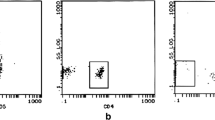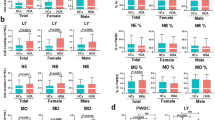Summary
Cultured interleukin 2 (IL-2)-dependent leukocytes from 13 patients with glutaric aciduria type I, 12 obligate carriers, 105 family members and 31 normal controls were assayed for glutaryl-CoA dehydrogenase activity. Of the 13 affected patients, 10 (all Ojibway Indian) had residual enzyme activity (2–13% of control) and 3 patients (all non-Indian) had undetectable enzyme activity. There was partial overlap between the distribution of enzyme activity in obligate heterozygotes and in normal controls (mean values±SD: 6.29±0.94 and 10.75±2.58 nmol/h per mg protein respectively). Using an arbitrary cutoff level of <7 nmol/h per mg protein as presumptive evidence of carrier status, the observed frequency of carriers did not differ significantly from that expected from theira priori risk of carrier status. Thirteen per cent of the family members had inconclusive status (activity between 7 and 8.5 nmol/h per mg protein). The method appears suitable for carrier detection, although definitive carrier assignment awaits identification of the mutation(s) responsible for glutaric aciduria type I.
Similar content being viewed by others
References
Adolph K, Kucey MT, Hodges SD, Carter RJ, Snyder FF (1988) Interleukin-2-dependent T lymphocytes for the diagnosis and investigation of inherited metabolic disorders.Clin Chim Acta 173: 147–156.
Amir N, Elpeleg ON, Shalev RS, Christensen E (1989) Glutaric aciduria type 1: Enzymatic and neuroradiologic investigations of two kindreds.J Pediatr 114: 983–989.
Besrat A, Polan CE, Henderson LM (1969) Mammalian metabolism of glutaric acid.J Biol Chem 244: 1461–1467.
Christensen E (1983) Improved assay of glutaryl-CoA dehydrogenase in cultured cells and liver: application to glutaric aciduria type I.Clin Chim Acta 129: 91–97.
Christensen E, Brandt NJ (1978) Studies on glutaryl-CoA dehydrogenase in leucocytes, fibroblasts and amniotic fluid cells. The normal enzyme and the mutant form in patients with glutaric aciduria.Clin Chim Acta 88: 267–276.
Goodman SI, Frerman FE (1989) Organic acidemias due to defects in lysine oxidation: 2-ketoadipic acidemia and glutaric acidemia. In Scriver CR, Beaudet AL, Sly WS, Valle D, eds.The Metabolic Basis of Inherited Disease, 6th edn. New York: McGraw-Hill, 845–853.
Haworth JC, Booth FA, Chudley AE et al (1991) Phenotypic variability in glutaric aciduria type I: report of fourteen cases in five Canadian Indian kindreds.J Pediatr 118: 52–58.
Morton DH, Bennett MJ, Seargeant LE, Nichter CA, Kelley RI (1991) Glutaric aciduria type I: a common cause of episodic encephalopathy and spastic paralysis in the Amish of Lancaster County, Pennsylvania.Am J Med Genet 41: 89–95.
Srere P (1969) Citrate synthase.Methods Enzymol 13: 3–16.
Stadtman ER (1957) Preparation and assay of acyl coenzyme A and other thiol esters.Methods Enzymol 3: 931–941.
Author information
Authors and Affiliations
Rights and permissions
About this article
Cite this article
Seargeant, L.E., Chudley, A.E., Dilling, L.A. et al. Carrier detection in glutaric aciduria type I using interleukin-2-dependent cultured lymphocytes. J Inherit Metab Dis 15, 733–737 (1992). https://doi.org/10.1007/BF01800015
Received:
Accepted:
Issue Date:
DOI: https://doi.org/10.1007/BF01800015




